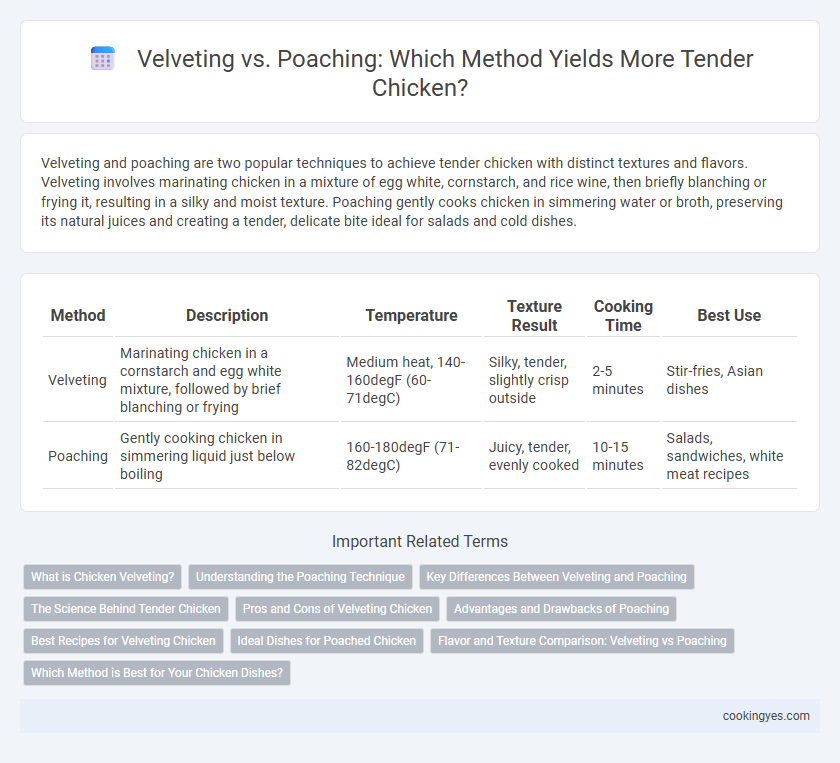Velveting and poaching are two popular techniques to achieve tender chicken with distinct textures and flavors. Velveting involves marinating chicken in a mixture of egg white, cornstarch, and rice wine, then briefly blanching or frying it, resulting in a silky and moist texture. Poaching gently cooks chicken in simmering water or broth, preserving its natural juices and creating a tender, delicate bite ideal for salads and cold dishes.
Table of Comparison
| Method | Description | Temperature | Texture Result | Cooking Time | Best Use |
|---|---|---|---|---|---|
| Velveting | Marinating chicken in a cornstarch and egg white mixture, followed by brief blanching or frying | Medium heat, 140-160degF (60-71degC) | Silky, tender, slightly crisp outside | 2-5 minutes | Stir-fries, Asian dishes |
| Poaching | Gently cooking chicken in simmering liquid just below boiling | 160-180degF (71-82degC) | Juicy, tender, evenly cooked | 10-15 minutes | Salads, sandwiches, white meat recipes |
What is Chicken Velveting?
Chicken velveting is a Chinese cooking technique that involves marinating chicken pieces in a mixture of cornstarch, egg white, rice wine, and sometimes soy sauce, then briefly blanching or lightly frying them to create a silky, tender texture. This method helps to seal in moisture and prevent the chicken from drying out during stir-frying, resulting in a smooth, velvety mouthfeel. Unlike poaching, which cooks chicken gently in water or broth, velveting enhances tenderness through a protective coating and quick, high-heat cooking.
Understanding the Poaching Technique
Poaching involves gently cooking chicken in simmering liquid at temperatures between 160degF and 180degF, preserving moisture and tenderness without drying the meat. This low-temperature technique ensures even cooking while infusing subtle flavors from broth, herbs, or aromatics used in the poaching liquid. Unlike velveting, which employs a cornstarch coating and brief high-heat cooking, poaching relies on slow, moist heat to achieve delicate, juicy chicken ideal for salads, soups, and light dishes.
Key Differences Between Velveting and Poaching
Velveting involves marinating chicken in a mixture containing cornstarch and egg white before briefly blanching it in oil or water, which creates a smooth, tender texture ideal for stir-frying. Poaching gently cooks chicken in simmering liquid, such as broth or water, at a low temperature, resulting in moist and evenly cooked meat with subtle flavor retention. Key differences lie in velveting's pre-cooking coating and quick blanching technique that preserve tenderness and create a sleek exterior, while poaching uses slow, gentle heat without coating for uniform doneness and moisture.
The Science Behind Tender Chicken
Velveting uses a coating of cornstarch, egg white, and sometimes rice wine or soy sauce to create a protective barrier that traps moisture and maintains tenderness during high-heat cooking. Poaching gently cooks chicken in simmering liquid at low temperatures, preventing muscle fibers from contracting and toughening, which preserves juiciness and texture. Both methods manipulate protein coagulation and water retention at the molecular level to produce tender chicken consistently.
Pros and Cons of Velveting Chicken
Velveting chicken creates a tender, silky texture by coating the meat in a protective cornstarch and egg white mixture before briefly blanching or frying, which helps the chicken retain moisture and prevents overcooking. The technique enhances flavor absorption but requires extra preparation time and can result in a slightly gelatinous coating if not executed properly. Velveting is ideal for stir-fry dishes where tender, juicy chicken is desired, but it may not suit recipes that demand a crisp or roasted texture.
Advantages and Drawbacks of Poaching
Poaching chicken offers the advantage of gentle cooking, preserving moisture and resulting in tender, juicy meat ideal for salads and soups. This method minimizes fat usage and retains nutrients better than high-heat techniques, but the drawback lies in its limited flavor development since it lacks the browning achieved in methods like velveting. Poached chicken may have a softer texture that some find less appealing, and the absence of a crispy exterior can reduce overall dish complexity.
Best Recipes for Velveting Chicken
Velveting chicken involves coating pieces in a mixture of egg white, cornstarch, and rice wine or soy sauce before briefly blanching or frying to lock in moisture and create a silky, tender texture ideal for stir-fries. This technique differs from poaching, which cooks chicken gently in liquid but often results in less tender, drier meat compared to velveting. Recipes like Chinese-style honey garlic chicken or ginger scallion chicken benefit from velveting to achieve juicy, melt-in-your-mouth tenderness that poaching alone cannot provide.
Ideal Dishes for Poached Chicken
Poaching chicken preserves moisture and tenderness, making it ideal for delicate dishes like chicken salad, shredded chicken soups, and chicken enchiladas. The gentle cooking method ensures even texture without dryness, perfect for recipes requiring shredded or diced chicken. Poached chicken's mild flavor also blends seamlessly in Asian chicken and rice dishes or cold chicken wraps.
Flavor and Texture Comparison: Velveting vs Poaching
Velveting chicken involves marinating and coating it in a starch mixture before briefly blanching in oil or water, resulting in a tender, silky texture that locks in moisture and enhances flavor absorption. Poaching gently cooks chicken in simmering liquid, producing a delicate, moist texture with a subtle, clean taste that allows natural flavors to shine without added richness. Both techniques yield tender results, but velveting offers a more velvety mouthfeel and intensified seasoning, while poaching delivers a lighter, pure chicken flavor.
Which Method is Best for Your Chicken Dishes?
Velveting uses a cornstarch and egg white coating to create ultra-tender chicken with a slightly crispy exterior, ideal for stir-fries and Asian dishes. Poaching involves gently cooking chicken in simmering liquid, preserving moisture and resulting in a tender, juicy texture perfect for salads, soups, and sandwiches. Choosing between velveting and poaching depends on whether you want crispy, flavorful chicken or moist, subtle-tasting meat in your dish.
Velveting vs Poaching for tender chicken Infographic

 cookingyes.com
cookingyes.com